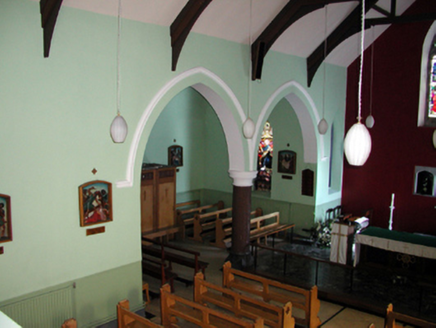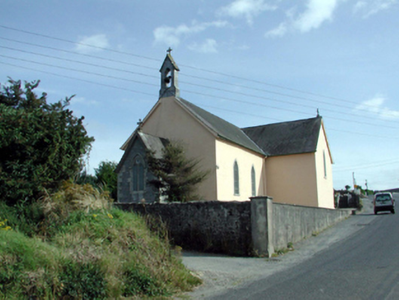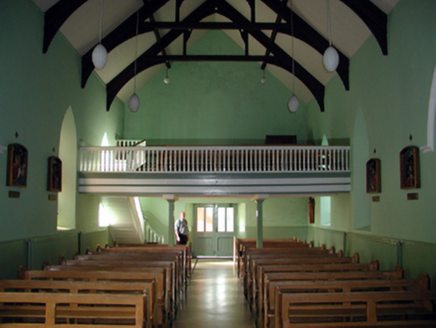Survey Data
Reg No
22901802
Rating
Regional
Categories of Special Interest
Architectural, Artistic, Historical, Social, Technical
Original Use
Church/chapel
In Use As
Church/chapel
Date
1820 - 1830
Coordinates
264141, 109169
Date Recorded
21/08/2003
Date Updated
--/--/--
Description
Detached four-bay double-height Catholic church, extant 1841, on a cruciform plan comprising two-bay double-height nave opening into single-bay (single-bay deep) double-height transepts centred on single-bay double-height chancel to crossing (south); single-bay single-storey gabled projecting porch to entrance (north) front. Renovated, ----, with sanctuary reordered. Pitched slate roof on a cruciform plan; pitched (gabled) slate roof (porch), roll moulded clay ridge tiles with cut-limestone buttressed gabled bellcote to apex to entrance (north) front framing embossed cast-iron bell, and cast-iron rainwater goods on timber eaves boards on exposed timber rafters retaining cast-iron downpipes. Rendered, ruled and lined battered walls on rendered chamfered plinth; tuck pointed snecked limestone walls (porch) on lichen-spotted cut-granite chamfered cushion course on plinth with hammered granite flush quoins to corners. Lancet window openings with cut-limestone sills, and cut-limestone surrounds having chamfered reveals framing storm glazing over fixed-pane fittings having margins centred on lattice glazing bars. Pointed-arch window opening (south) with cut-limestone mullions, and cut-limestone block-and-start surround having chamfered reveals framing storm glazing over fixed-pane fittings having leaded stained glass panels. Pointed-arch window opening (porch) with cut-granite Y-mullion, and cut-granite block-and-start surround having chamfered reveals with hood moulding on monolithic label stops framing storm glazing over fixed-pane fittings having margins centred on square glazing bars. Pointed-arch opposing door openings ("cheeks") with cut-granite block-and-start surrounds having chamfered reveals with hood mouldings on monolithic label stops framing timber boarded doors. Interior including vestibule (north); square-headed door opening into nave with glazed timber boarded double doors; full-height interior open into roof with balustraded choir gallery (north) on square profile posts, central aisle between cruciform-detailed timber pews, pointed-arch arcades (transepts) on polished red granite pillars, stepped dais to sanctuary to crossing (south) reordered, ----, with timber panelled altar below stained glass "South Window" (----), and exposed collared timber roof construction with wind braced ceiling. Set in landscaped grounds.
Appraisal
A church representing an important component of the early nineteenth-century ecclesiastical heritage of the outskirts of Waterford with the architectural value of the composition, one showing the hallmarks of a period of construction coinciding with the dismantling of the Penal Laws under the Roman Catholic Relief Act, 1829, confirmed by such attributes as the traditional cruciform plan form, aligned along a liturgically-incorrect axis; the battered silhouette; the slender profile of the openings underpinning a "medieval" Gothic theme with the chancel defined by a cinquefoil-detailed "South Window"; and the handsome bellcote embellishing the roofline as a picturesque eye-catcher in the landscape. Having been well maintained, the elementary form and massing survive intact together with quantities of the original fabric, both to the exterior and to the interior reordered (----) in accordance with the liturgical reforms sanctioned by the Second Ecumenical Council of the Vatican (1962-5) where contemporary joinery; and a vibrant "South Window" presented 'IN GRATITUDE TO GOD FROM THE PRIESTS & PEOPLE OF THIS PARISH', all highlight the artistic potential of the composition: meanwhile, an exposed timber roof construction pinpoints the engineering or technical dexterity of a church making a pleasing visual statement in a suburbanised street scene.











